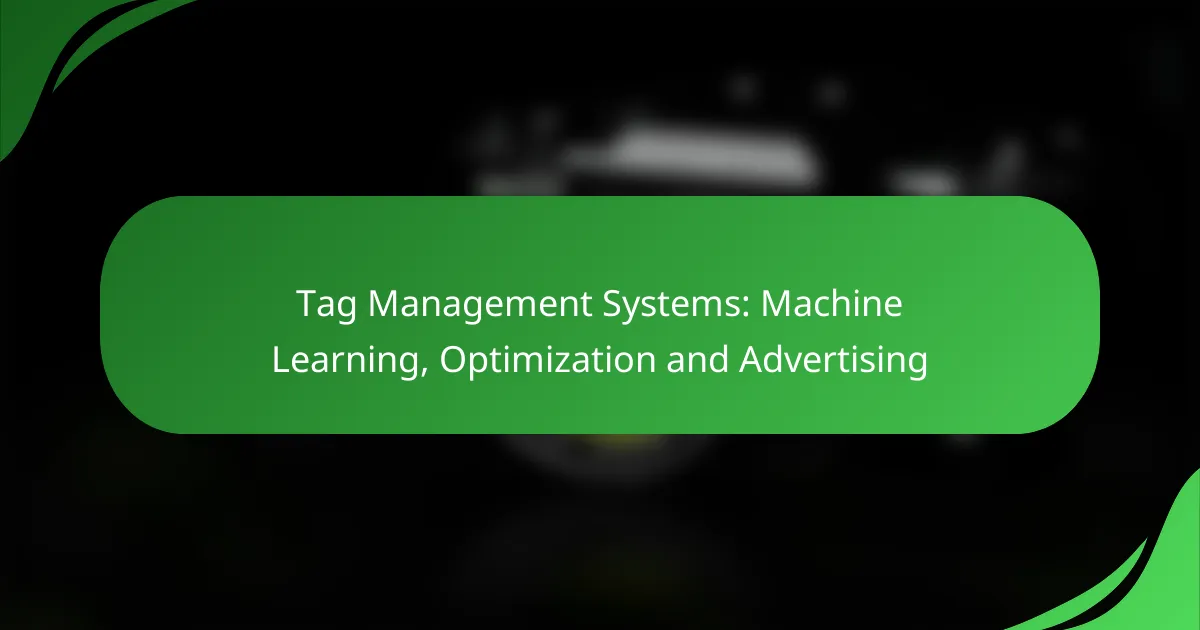Tag Management Systems (TMS) play a crucial role in enhancing advertising effectiveness by streamlining the management of marketing tags and enabling advanced tracking capabilities. By integrating machine learning, TMS can automate data processing and improve ad targeting, leading to more efficient marketing strategies. Regular audits and the use of analytics tools further optimize these systems, ensuring that businesses achieve better performance and return on investment.

How do Tag Management Systems enhance advertising in Canada?
Tag Management Systems (TMS) significantly enhance advertising in Canada by optimizing the deployment and management of marketing tags. They enable advertisers to implement advanced tracking and analytics, leading to better-targeted campaigns and improved return on investment.
Improved ad targeting
Tag Management Systems enhance ad targeting by allowing marketers to collect and analyze user behavior data more effectively. This data can be used to create detailed audience segments, ensuring that ads reach the right consumers at the right time.
For example, a TMS can track user interactions on a website and trigger specific ads based on their interests or previous actions. This level of personalization can lead to higher engagement rates and conversion metrics.
Real-time data collection
Real-time data collection is a key feature of Tag Management Systems, enabling advertisers to monitor campaign performance as it happens. This immediacy allows for quick adjustments to strategies based on current data trends.
In Canada, where consumer preferences can shift rapidly, having access to real-time analytics can help advertisers pivot their campaigns effectively. For instance, if a particular ad is underperforming, marketers can quickly modify the targeting parameters or creative elements to improve results.
Streamlined campaign management
Tag Management Systems streamline campaign management by centralizing the control of various marketing tags into one platform. This reduces the complexity of managing multiple tags and minimizes the risk of errors that can occur with manual implementations.
With a TMS, Canadian advertisers can deploy tags across different channels without needing extensive technical support. This efficiency not only saves time but also allows for more agile marketing practices, enabling teams to focus on strategy rather than technical execution.

What are the benefits of machine learning in Tag Management Systems?
Machine learning enhances Tag Management Systems (TMS) by automating data processing, improving ad targeting, and optimizing user interactions. These benefits lead to more efficient marketing strategies and better overall performance.
Automated data analysis
Machine learning algorithms can automatically analyze vast amounts of data collected through tags, identifying patterns and trends that would be difficult for humans to detect. This capability allows marketers to gain insights into user behavior and campaign effectiveness quickly.
For example, a TMS can process data from multiple sources, such as website visits and social media interactions, to provide a comprehensive view of customer engagement. This analysis can help businesses make informed decisions about where to allocate their advertising budget.
Predictive analytics for ad performance
Predictive analytics powered by machine learning can forecast the performance of advertising campaigns based on historical data. By analyzing past interactions and conversions, TMS can predict which ads are likely to perform well and which may need adjustments.
Marketers can use these insights to optimize their campaigns in real-time, adjusting targeting parameters or creative elements to improve outcomes. This proactive approach can lead to higher conversion rates and better return on investment.
Enhanced user experience
Machine learning can significantly enhance user experience by personalizing content and advertisements based on individual preferences and behaviors. TMS can leverage user data to deliver targeted messages that resonate with specific audiences.
For instance, a TMS might analyze a user’s past interactions to recommend products or services that align with their interests. This tailored approach not only increases engagement but also fosters customer loyalty and satisfaction.

How can businesses optimize their Tag Management Systems?
Businesses can optimize their Tag Management Systems (TMS) by implementing regular audits, integrating analytics tools, and utilizing A/B testing. These strategies ensure that tags are functioning effectively, provide valuable insights, and enhance overall marketing performance.
Regular audits and updates
Conducting regular audits of your Tag Management System is essential for maintaining optimal performance. This process involves reviewing existing tags, checking for errors, and ensuring that all tags are up-to-date with the latest tracking requirements.
Set a schedule for audits, ideally every quarter, to identify any discrepancies or outdated tags. This proactive approach helps prevent potential data loss and ensures compliance with privacy regulations, such as GDPR or CCPA.
Integration with analytics tools
Integrating your Tag Management System with analytics tools allows for seamless data collection and analysis. By connecting tools like Google Analytics or Adobe Analytics, businesses can track user behavior and gain insights into campaign performance.
Ensure that your TMS supports the analytics platforms you use. This integration enables real-time data access, allowing for quicker decision-making and adjustments to marketing strategies based on user interactions.
Utilizing A/B testing
A/B testing is a powerful method to optimize your Tag Management System by comparing different versions of tags to determine which performs better. This technique can help refine marketing strategies and improve conversion rates.
Implement A/B testing by creating variations of tags and measuring their impact on user engagement and conversion metrics. Aim for a sample size that provides statistically significant results, typically in the low hundreds to thousands, depending on your traffic volume.

What are the key features of popular Tag Management Systems?
Popular Tag Management Systems (TMS) streamline the process of managing and deploying marketing tags on websites. They enhance data collection, improve site performance, and allow for more efficient marketing strategies.
Google Tag Manager
Google Tag Manager (GTM) is a free tool that simplifies the management of JavaScript and HTML tags used for tracking and analytics. It allows users to deploy tags without modifying the code directly, which can save time and reduce errors.
Key features include version control, built-in templates for popular tags, and a user-friendly interface. GTM also integrates seamlessly with Google Analytics and other Google services, making it a popular choice for businesses already using these tools.
Adobe Launch
Adobe Launch is part of the Adobe Experience Cloud and offers advanced tag management capabilities tailored for enterprises. It provides a flexible architecture that allows for custom integrations and the use of extensions to enhance functionality.
With Adobe Launch, users can manage multiple environments, enabling testing and staging before deploying changes to production. This system is particularly beneficial for organizations that require robust data governance and compliance with privacy regulations.
Tealium iQ
Tealium iQ is a comprehensive tag management solution that focuses on real-time data collection and audience segmentation. It offers a wide range of integrations with third-party tools and supports data privacy compliance, making it suitable for businesses with strict regulatory requirements.
Tealium iQ features a visual interface for tag management, allowing users to create and manage tags easily. Additionally, it provides advanced capabilities such as event tracking and audience management, which can enhance marketing effectiveness.

What criteria should be considered when selecting a Tag Management System?
When selecting a Tag Management System (TMS), consider factors such as ease of use, integration capabilities, and cost-effectiveness. These criteria will help ensure that the TMS meets your organization’s needs and enhances your digital marketing efforts.
Ease of use
Ease of use is crucial for a Tag Management System, as it affects how quickly your team can implement and manage tags. Look for a TMS with an intuitive interface that allows users to create, edit, and deploy tags without extensive technical knowledge.
Consider systems that offer drag-and-drop functionality or visual tag management features. This can significantly reduce the learning curve and improve efficiency, enabling your team to focus on strategy rather than technical hurdles.
Integration capabilities
Integration capabilities are essential for a TMS to work effectively with your existing tools and platforms. A good TMS should support seamless integration with analytics, advertising, and content management systems.
Check for pre-built connectors or APIs that facilitate integration with popular services like Google Analytics, Facebook Ads, and CRM systems. This will ensure that your data flows smoothly across platforms, enhancing your marketing efforts.
Cost-effectiveness
Cost-effectiveness is a key consideration when selecting a Tag Management System, as pricing can vary widely. Evaluate the total cost of ownership, including setup fees, monthly subscriptions, and potential costs for additional features or support.
Compare different TMS options to find one that fits your budget while still meeting your functional requirements. Keep in mind that a more expensive system may offer better features or support, which can lead to long-term savings through improved efficiency and effectiveness.

How do Tag Management Systems impact data privacy regulations in Canada?
Tag Management Systems (TMS) significantly influence data privacy regulations in Canada by facilitating compliance with laws like the Personal Information Protection and Electronic Documents Act (PIPEDA). These systems help organizations manage and control the data collected through various tags, ensuring that user consent and data handling practices align with legal requirements.
Compliance with PIPEDA
Compliance with PIPEDA is essential for organizations operating in Canada, as it governs how personal information is collected, used, and disclosed. Tag Management Systems can streamline this process by enabling businesses to implement consent management tools that ensure users are informed about data collection practices.
To achieve PIPEDA compliance, organizations should regularly audit their tags and data collection methods. This includes ensuring that any third-party tags used do not compromise user privacy and that users can easily withdraw consent if desired. A practical step is to maintain a clear inventory of all tags and their purposes.
Common pitfalls include neglecting to update consent mechanisms as regulations evolve or failing to provide users with clear options regarding their data. Organizations should prioritize transparency and user control to foster trust and comply with PIPEDA effectively.



